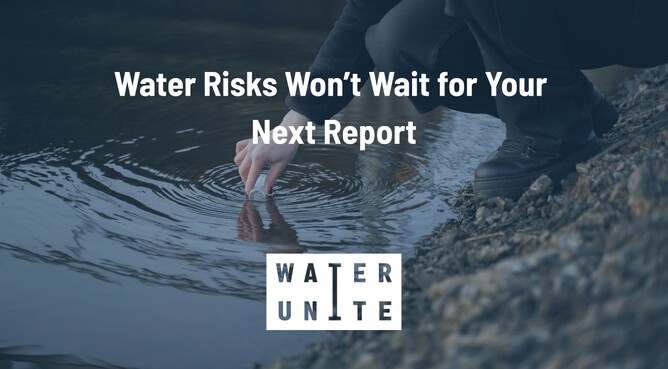As ESG frameworks continue to shape how companies are valued, regulated, and held accountable, a notable inconsistency remains in how environmental risks are reported. In most corporate disclosures, climate related metrics such as carbon emissions or energy efficiency take centre stage. These are essential no doubt, but they represent only part of the picture. Water, one of the most fundamental inputs across all industries, remains understudied, underreported, and often misunderstood in ESG frameworks. This underrepresentation is more than an omission, it reflects a structural gap in how sustainability is perceived, implemented, and acted upon (CDP, 2023).
Water connects nearly every aspect of the sustainability development agenda. It underpins food systems, public health, biodiversity, and industrial production. Yet it is still not treated with the same strategic weight or regulatory urgency in reporting frameworks as emissions or energy. According to leading analysts, this failure is not just a disclosure problem; it can expose businesses to significant financial, operational, and reputational risks in a world increasingly shaped by resource constraints and climate volatility (UN Water, n.d.; World Bank, 2016).
Strengthening water reporting in ESG frameworks is not a matter of compliance alone. It is a necessary step toward resilience, risk mitigation, and long term value creation. With global freshwater demand set to outstrip supply by 40 percent by 2030 if current trends continue (UN Water, n.d.), the question is no longer whether businesses should pay attention to water, but how urgently they can adapt their reporting and response.
The Case for Water as a Material Risk
The case for more comprehensive water reporting is not abstract, it is anchored in clear, measurable risk. CDP’s latest Global Water Report demonstrates that nearly 70 percent of the world’s largest companies are already experiencing exposure to water related risks that could result in financial losses (CDP, 2023). The total value at risk is estimated at over $225 billion USD. And these are self reported figures, meaning the actual scale may be even greater.
Business continuity is increasingly shaped by water availability, quality, and regulation. In Brazil, a prolonged drought in 2015 disrupted hydroelective electricity supply and forced major manufacturers like General Motors to increase operational spending by millions of dollars to cope with water and energy shortages (S&P Global, 2023). Similarly, in Taiwan, a severe drought in 2021 put pressure on the semiconductor industry, forcing companies like TSMC to truck in water to keep their factories running. The situation drove up costs and showed how local water stress can have a far reaching impact on global supply chains. With more than 40% of the world’s chip manufacturing facilities expected to face high water risk by 2040, companies are under growing pressure to assess and address water risk where it matters most (WRI, 2021; Nikkei Asia, 2021).
These are not local anomalies. The World Bank reports that global water related climate shocks will wipe out up to six percent of GDP in some regions if no adaptations to current practices are made (World Bank). Scarcity is already causing supply chain disruptions across agriculture intensive sectors like textiles and food, which rely heavily on water for raw material production. With agriculture accounting for approximately 70% of global freshwater withdrawals (FAO, n.d.), it is impossible to have an accurate overview of operations risk without a clear understanding of water use and dependence.
Nevertheless, a 2023 assessment by CDP shows that while 91 percent of ESG committed companies disclose emissions, only 40 percent provide water related disclosures at a meaningful level (CDP, 2023). Even fewer report specifics around governance, risk projections, or water stress mitigation plans. In effect, companies are underreporting a growing risk area that threatens both the planet and profit.
Why ESG Reporting on Water Falls Short
Companies tend to treat water as a uniform commodity and report on it accordingly. This is a fundamental error. Carbon emissions are globally cumulative; water is not. Every use of water is context specific, shaped by seasonal, ecological, and social factors. Using 1L of water in Scotland is not equivalent to using the same amount in Rajasthan or the Sahel. ESG disclosures typically offer aggregate water data at the global or regional level, failing to account for site level water stress or basin level social impacts (WWF, n.d.; WRI, n.d.).
Second, standards remain fragmented and underutilised. Frameworks such as CDP Water Security, GRI 303, and the European Union’s CSRD provide standards and guidelines for disclosure, but implementation is uneven, especially among private companies and multinationals operating in less regulated markets (CDP, 2023; GRI, 2018; European Commission, n.d.). Even where companies do report, the lack of comparability, verification, and depth limits the usefulness of the data.
Moreover, while carbon reporting is increasingly forward looking, featuring science-aligned reduction pathways and net zero targets, water remains backward facing. Few disclosures include future demand projections, long term availability models, or watershed level scenario analysis, despite the availability of widely used tools like the WWF Water Risk Filter and WRI Aqueduct. The absence of future risk visibility renders the disclosures of limited value for scenario based decision making or investor due diligence.
Finally, a company’s true water footprint is often embedded within its suppliers. Few ESG reports examine upstream water dependency or risk exposure, particularly in agriculture heavy or complex manufacturing supply chains. Only 31 percent of responding corporations in CDP’s latest water report indicated that they assess water risk throughout their value chains (CDP, 2023). This leaves out core parts of a company’s risk profile, and overlooks key opportunities for mitigation through supplier engagement, technology, and sustainable sourcing.
Lessons from the Real World
Real world examples underscore the consequences of weak water reporting and planning. In 2018, Cape Town found itself at the centre of global headlines as it approached “Day Zero”’, a near total municipal water shutdown that would have affected over four million people. Hotels installed desalination units, businesses slashed water use, and tourism dropped dramatically. Beverage brands scrambled for tankers as operations stalled. Though catastrophe was narrowly avoided, the disruption illustrated the limits of reactive water governance in the face of sustained stress (World Bank, 2018). Notably, in 2019, the Greater Cape Town Water Fund brought together local and international partners to help strengthen Cape Town’s water supply and resilience. Targeted support which included funding from Water Unite enabled the development of support tools and funding strategies. This helped the city invest in long term watershed security and crisis preparedness (Water Unite, 2019/2020 Impact Report).
Meanwhile, in Zaragoza, Spain, once facing chronic overuse and inefficiency, long term partnerships between civil society, businesses, and municipal authorities transformed the city into a model of sustainable urban water management, reducing consumption by more than 30 percent in just one decade (WWF Europe, n.d.). These changes required not just infrastructure, but consistent data, stakeholder coordination, and proactive strategy.
What Better ESG Water Reporting Looks Like
Fixing the reporting gap begins with an understanding that water risk is inherently local, and must be treated as such. Basin specific data, scenario planning, and water source mapping should replace generic withdrawal numbers. Companies should disclose where their operations are located in relation to high risk areas using tools like the WWF Water Risk Filer or WRI Aqueduct. Transparency around where, when, and how companies use water and mitigate impacts is critical (WWF, n.d.; WRI, n.d.).
Best practice ESG reports present water risk as a corporate governance issue. That means identifying who at board or executive level is accountable for water related strategy, tracking progress through time bound KPIs, and reporting on risk across operations, suppliers, and end markets (CDP; GRI). Engagement with local authorities, indigenous groups, regulators, and NGOs should be embedded into the reporting process to ensure data is credible and solutions are inclusive.
Disclosure should also move upstream. Water use, runoff, and contamination in supply chains (particularly for companies sourcing soy, cotton, coffee, meat, or flax) represent major blind spots. There is growing interest in supply chain focused water metrics, but far too few companies trace this dependence or include it in ESG updates (CDP, 2023).
Closing the Reporting Gap
Water security is not a peripheral issue, it is one of the defining business challenges of this century. Whether through climate shocks, competition for resources, reputational risks, or regulation, water is fast becoming a key determinant of long-term strategic stability (World Bank).
The current gap in ESG reporting leaves companies and investors with an incomplete picture of environmental risk. It ignores asymmetries between sites, masks vulnerabilities, and fails to prepare businesses for the future. Closing that gap is not just a matter of refining metrics, it is an obligation to align action with values and risk with responses.
Organisations that place water front and centre in their ESG frameworks (backed by data, partnerships, and transparency) will be better places to weather both market scrutiny and environmental stress. Those who fail to evolve may find their operations, reputations, and outcomes under water, both literally and figuratively.
References
CDP. (2023). Global Water Report 2023. CDP. http://www.cdp.net/en/research/global-reports/water-report
CDP. (n.d.). Water Security Questionnaire Guidance for Companies. CDP. http://www.cdp.net/en/guidance/guidance-for-companies
European Commission. (n.d.). Corporate Sustainability Reporting Directive (CSRD). https://finance.ec.europa.eu/capital-markets-union-and-financial-markets/company-reporting-and-auditing/corporate-sustainability-reporting_en
Food and Agriculture Organization of the United Nations. (n.d.). Water use in agriculture. http://www.fao.org/water/en/
Global Reporting Initiative. (2018). GRI 303: Water and Effluents 2018. https://www.globalreporting.org/standards/media/1910/gri-303-water-and-effluents-2018.pdf
S&P Global. (2023). Water scarcity brings $225 billion in business risk—report finds. http://www.spglobal.com/esg/insights/water-scarcity-brings-225-billion-in-business-risk-report-finds
UN Water. (n.d.). Water facts: Scarcity. http://www.unwater.org/water-facts/scarcity
World Bank. (2018, March 5). Cape Town’s water crisis shows us our relationship with water. http://www.worldbank.org/en/news/feature/2018/03/05/cape-town-water-crisis-shows-us-our-relationship-with-water
World Bank. (2016). High and dry: Climate change, water, and the economy. http://www.worldbank.org/en/topic/water/publication/high-and-dry-climate-change-water-and-the-economy
World Resources Institute. (n.d.). Aqueduct water risk atlas. http://www.wri.org/aqueduct
WWF. (n.d.). Water risk filter. https://waterriskfilter.panda.org/
WWF Europe. (n.d.). Zaragoza urban water losses case study. http://www.wwf.eu/?235091/Zaragoza-Urban-Water-Losses
World Resources Institute. (2021, December 2). How water stress threatens the semiconductor industry. https://www.wri.org/insights/how-water-stress-threatens-semiconductor-industry
Nikkei Asia. (2021, April 26). Taiwan’s chip industry under threat as drought turns critical. https://asia.nikkei.com/Business/Tech/Semiconductors/Taiwan-s-chip-industry-under-threat-as-drought-turns-critical
S&P Global. (n.d.). Electricity shortages and climate change in Brazil: A case study. https://www.spglobal.com/esg/s1/research-analysis/electricity-shortages-and-climate-change-in-brazil.html

